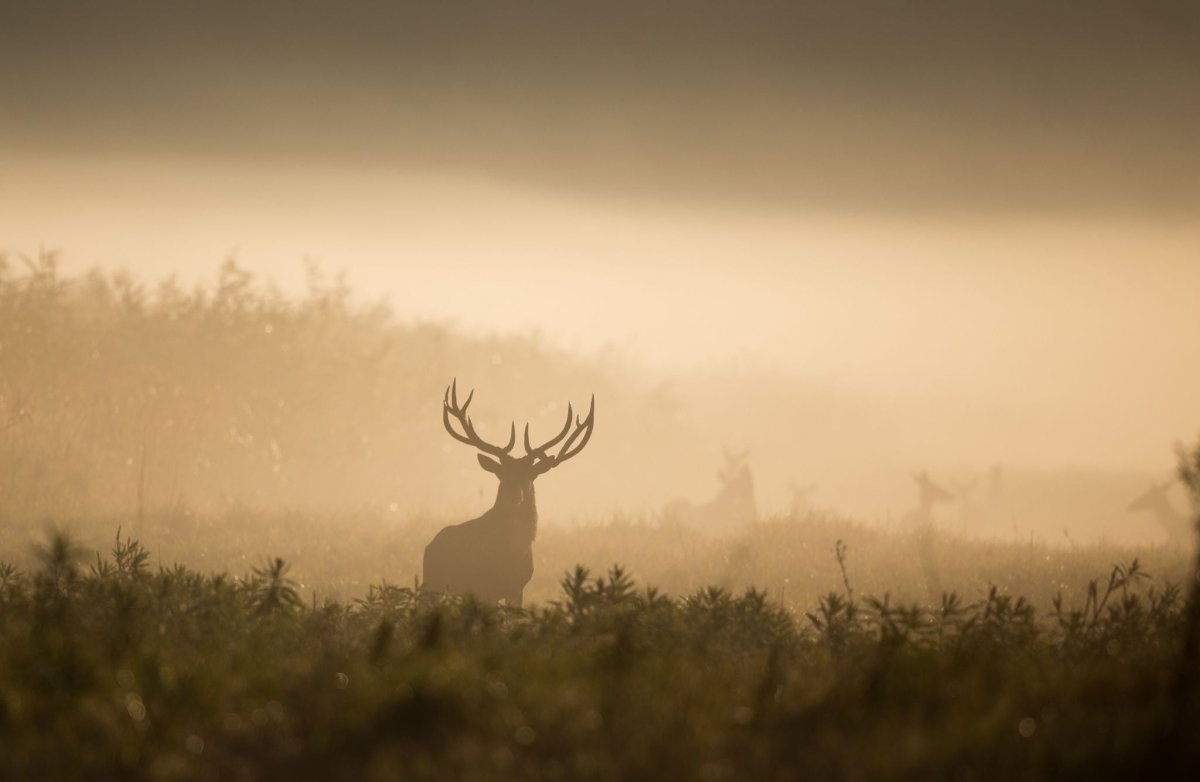Why Is Wildlife Research Important To Hunting?

Ecosystems evolve, so what is good for the ecosystem one year may not be good for the next year or five years. An ecosystem may improve or degrade over time, and scientists need to research to understand the trends and what can be done to sustain a positive trend or end a negative trend.
It’s like a giant circle.
Hunting is an important funding source for wildlife research, and wildlife research is essential to hunting because it helps sustain the populations we hunt. Let’s begin with how hunting is important for wildlife research.
Hunting Is Important for Wildlife Research
Laws have been enacted specifically to provide federal and state fish and wildlife agencies funding. For example, the Federal Aid in Wildlife Restoration Act, also known as the Pittman-Robertson Act, initiated an 11% tax on firearms, ammunition, and archery equipment.
These funds are distributed to state fish and wildlife agencies. A similar law created an excise tax on fishing equipment, the Dingell-Johnson Sport Fish Restoration Act. The Migratory Bird Hunting Stamp Act, or Duck Stamp Act, requires hunters purchase a stamp prior to hunting migratory waterfowl such as ducks and geese.
Through these laws, hunting directly supports wildlife research and the environment. Revenue from licenses and excise taxes on equipment (including guns) and ammunition funds restoration, conservation, and wildlife research.
Overall, funding from sportsman-derived sources makes up 60-90 percent of a state’s fish and wildlife budget. Without hunting, this primary funding source would not exist.
One of the main activities that hunting supports is wildlife research, so it is easy to recognize that some wildlife research would be at risk if the funding provided by sportsman-derived sources was reduced or eliminated.
What Does the Research Tell Us?
If hunting is essential to fund wildlife research, what does the research do for hunting? In the late 1800s, hunters actually advocated for wildlife research and hunting regulations in response to declining wildlife numbers. Today, hunting is highly regulated, with states establishing hunting seasons, bag limits, and more.
Wildlife research allows for informed decisions based on science that determine how hunting is conducted.
For example, suppose wildlife managers recognize that the population of white-tailed deer is too large to sustain the ecosystem. In that case, they may increase the duration of the hunting season and allow harvesting of does to reduce the population and reduce the number of fawns born.
The reverse is true if wildlife managers recognize the population needs to increase.
Hunters often help in this process by responding to state and federal surveys to report the number and location of animals harvested. This is an integral part of wildlife research because it allows wildlife biologists to evaluate the number of animals harvested over time and compare that to the population.
Healthy populations of wildlife promote a healthy environment overall. Overpopulation causes degradation of the environment, reducing the viability of the species living there. This includes plants, animals, birds, and even insects. Using wildlife research (including collecting information from hunters), states can better manage their wildlife populations.
Understanding Trends Can Be Complicated
What happens when a formerly abundant species declines? What if the average seasonal numbers decrease, but we find the species is much greater in the off-season? Has the ecosystem changed so that the food source is more abundant in a different season? Has the species changed their behavior for some reason?
You can bet hunters (and wildlife biologists) want to know what happened to reduce the numbers. Wildlife research can help solve the puzzle and lead to different management decisions that help the species recover.
Research can tell us that a favorite food source is no longer available in a specific location, and wildlife has responded. The plants are still there, but the insects that are a food source (say for quail) are no longer there due to pesticide use. Scientists look at the whole picture to figure out these complicated situations.
What About Species That Travel Long Distances?
Migratory birds travel long distances, even across continents. How is hunting for these species managed? Seasons for ducks and geese are adjusted to account for migration timing and are managed under a federal framework instead of state regulations.
The best available science (wildlife research) is used to determine migration timing. Each year, hundreds of thousands of ducks and geese are banded by federal, state, and provincial agencies, millions of square miles of breeding habitat are surveyed, and hunting activity and harvest numbers are studied.
This annual wildlife research is vital to understanding current conditions. For example, drought or other weather phenomena can drastically affect all species. When that species migrates long distances, the drought that occurred thousands of miles away affects the number of birds that fly over your favorite hunting spot.
Understanding population trends over time and considering all factors (like weather) ensures the long-term viability of the species and your ability to hunt that species.
Wildlife Research in Action
There are many examples of wildlife research in action, but here are three examples of the importance of wildlife research for hunting.
Quail and Cotton Rats
Wildlife research helps test and refine previously held beliefs. For example, in the 1920s, scientists believed that cotton rats were bad for quail populations because it was thought that the rats ate quail eggs.
Recent wildlife research using techniques not available in 1920, like remote video cameras, found that cotton rats were not eating the in-tact eggs. Instead, the research found that cotton rats were actually cleaning up eggshells left by predators who had previously eaten the eggs.
In fact, the research found that cotton rats were preferred by predators, meaning as cotton rat populations increased, quail predation decreased. As it turns out, controlling cotton rats probably was more detrimental to the quail population than leaving them alone. Without the cotton rats to eat, the predators ate more quail eggs!
Deer Browsing in Forests
When scientists noticed a problem in a forest in northern Minnesota, they recognized that research was needed to understand what was going on. The problem was no new trees were sprouting and surviving in the forest. The forest had a healthy population of mature trees, so what was wrong?
The first clue was the scientists noticed that certain trees (white pine and white cedar) showed evidence of heaving deer browsing.
In the study, several areas were fenced to keep the deer out. The areas were checked over time, and the scientists discovered new white pine and white cedar seedlings in all fenced-off plots. The areas outside the fenced-off plots still had no regeneration of these trees.
Scientists also noticed that the dominant species outside the fenced areas had shifted to a species that had little nutritional value for deer (white spruce). The deer were causing the environment to become less diverse and less suitable for their survival. This trend affected all species who relied on the original, various forest plants.
Ultimately, the study found that deer browsing caused severe impacts on Minnesota forests, which led to the reforestation and the management of the deer population.
Feral Hogs and Impacts On Wildlife
It is widely understood that feral hogs are competitors for native wildlife, meaning they eat the food that the native animals rely on for survival, but did you know that hogs are also predators? Hogs are omnivores meaning they eat whatever is available, plant or animal.
This is particularly troublesome for ground-nesting birds like wild turkey and quail.
Wildlife biologists have teamed with landowners in central Texas to understand the problem better. Studies were designed and conducted to determine predation rates on bobwhite quail nests. The study confirmed that predation by feral hogs was a factor in the decline of bobwhite quail in that area. The same results were found when studying wild turkeys in east Texas.
Hog gestation is just 115 days to compound the problem, and offspring reach sexual maturity in just six months. That means the population of hogs in an area can triple in just over a year. Modeling data in Texas suggests that almost two million hogs need to be harvested each year to keep the overall numbers static. As a result, hog hunting is allowed year-round in Texas. More research is needed.
 Essential Practices
Essential Practices
Hunting helps wildlife research, and wildlife research helps hunting. It’s a circular situation. Hunting provides necessary funding for wildlife research, and hunters offer valuable information for wildlife researchers. The information gained through wildlife research helps sustain healthy ecosystems and populations to hunt.
As we learn more about wildlife, we learn how to be better hunters at GunSkins. Learning about how particular environments change through the seasons helps us better understand how to camouflage ourselves, including our weapons with different camo patterns. With environment-specific camo patterns, our gear can blend into our surroundings rendering us one with the foliage around us.
Sources:
The Importance of Scientific Wildlife Research | National Bobwhite Conservation Initiative
The Role of Hunting in Wildlife Conservation, Explained | College of Natural Resources News
The Impact of Deer Browsing on Forests | The Nature Conservancy



0 comments